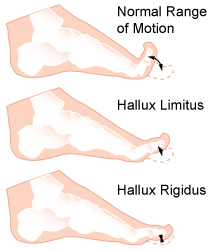Hallux Limitus – ‘Stiff Big Toe’
Even though the big toe is only a small part of your body, if it becomes stiff and painful it can make it difficult to walk normlly. Hallux is a term used by podiatrists for the big toe. Hallux limitus is a condition that involves the joint at the base of the big toe, which is called the ‘first metatarsophalangeal’ joint of the foot.

Stiff big toe joint / Hallux Limitus
Normally, when you are standing the big toe can be bent upwards and this movement occurs pain-free and unrestricted. During walking the big toe must bend upwards and ‘dorsiflex’ so that the foot can roll over the top and push off the ground. This is important during walking so that the body can generate power to move forwards. If this movement does not occur it will put strain on other parts of the leg and foot and overtime may also cause pain or muscle fatigue.
Hallux limitus occurs when the range of motion of the big toe joint is restricted, shown in the above image. This restriction may occur due to a number of factors including:
- Injury or trauma to the big toe
- Overuse – common in athletes or occupations where repetitive movement through the big toe, such as squatting, is common e.g. mechanics
- A deviation from normal foot structure and function
- Conditions or diseases that involve the big toe joint such as bunions
Initially, hallux limitus may have no symptoms but as the condition progresses symptoms may present. The most common symptom is a stiff or painful big toe, especially when walking and pushing the foot off the ground.
Hallux limitus is classed as a degenerative joint disease and as the condition progresses changes occur to the two bones of the joint. Commonly, a bony bump may form like a collar over the top of the joint. Once bony changes occur they will cause a permanent decrease in how far the toe can bend upwards and if not managed correctly further deterioration of the bones of the joint will occur.
To diagnose hallux limitus a podiatrist will need to carry out a physical assessment of the foot. Treatment is aimed at restoring function of the big toe joint and limiting the progression of the bony changes.
Treatment and management of this condition involves footwear advice including shoes that do not restrict the toes or opting for a stiff soled shoe, orthotics to support the big toe joint and facilitate its function when walking, pain management strategies, and lastly exercises and stretches to keep the joint mobile.
For more information on the management and treatment of hallux limitus further browse to What is the cure for bunions? How do you treat bunions? How do you treat sesamoiditis? How do you treat hallux limitus? : Podiatry FAQs : 56

Recent Comments